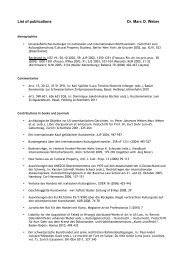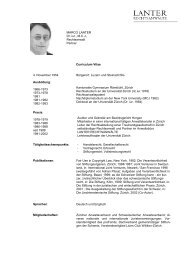Liability for the Acquisition of Faked or Wrongly Attributed Works of ...
Liability for the Acquisition of Faked or Wrongly Attributed Works of ...
Liability for the Acquisition of Faked or Wrongly Attributed Works of ...
Create successful ePaper yourself
Turn your PDF publications into a flip-book with our unique Google optimized e-Paper software.
exander Calder (1898–1976) and sued on fraud and contract claims. The trial<br />
court rejected <strong>the</strong> view <strong>of</strong> <strong>the</strong> plaintiffs’ expert that <strong>the</strong> w<strong>or</strong>k was not <strong>the</strong> au<strong>the</strong>ntic<br />
w<strong>or</strong>k, 13 and <strong>the</strong>re<strong>f<strong>or</strong></strong>e dismissed <strong>the</strong> complaint. Its conclusion was based<br />
largely on its view that <strong>the</strong> plaintiffs’ expert, who had been Calder’s exclusive<br />
dealer and was an acknowledged preeminent expert on Calder’s w<strong>or</strong>k, had conducted<br />
too curs<strong>or</strong>y an examination <strong>of</strong> <strong>the</strong> sculpture to warrant <strong>the</strong> adoption <strong>of</strong> his<br />
opinion that <strong>the</strong> w<strong>or</strong>k was inau<strong>the</strong>ntic. 14<br />
2. Implied warranty<br />
Whe<strong>the</strong>r <strong>the</strong> U.C.C. applies to actions <strong>of</strong> implied warranties <strong>f<strong>or</strong></strong> art au<strong>the</strong>ntications<br />
is unclear. U.C.C. § 2-314 provides in relevant part:<br />
414<br />
“(1) […] a warranty that <strong>the</strong> goods shall be merchantable is implied in a contract <strong>f<strong>or</strong></strong> <strong>the</strong>ir<br />
sale if <strong>the</strong> seller is a merchant with respect to goods <strong>of</strong> that kind. […].<br />
(2) Goods to be merchantable must be at least such as (a) pass without objection in <strong>the</strong><br />
trade under <strong>the</strong> contract description; and […] (f) con<strong>f<strong>or</strong></strong>m to <strong>the</strong> promise <strong>or</strong> affirmations <strong>of</strong><br />
fact made on <strong>the</strong> container <strong>or</strong> label if any.”<br />
In Balog v. Center Art Gallery-Hawaii, Inc., 15 <strong>the</strong> District Court <strong>f<strong>or</strong></strong> <strong>the</strong> District<br />
<strong>of</strong> Hawaii rejected <strong>the</strong> applicability <strong>of</strong> implied warranties to au<strong>the</strong>ntication actions.<br />
In McKie v. R.H. Love Galleries, Inc., 16 <strong>the</strong> District Court <strong>f<strong>or</strong></strong> <strong>the</strong> N<strong>or</strong><strong>the</strong>rn<br />
13 See Greenberg Gallery, Inc. v. Bauman (supra note 12), 174: “I conclude <strong>the</strong> rec<strong>or</strong>d and<br />
<strong>the</strong> circumstantial evidence […] creates a strong presumption that it is an au<strong>the</strong>ntic Calder“.<br />
The same view was taken in a French case, Cour de cassation, 28.11.1995, pourvoi<br />
no. 93-16478, unpublished, where <strong>the</strong> court did not follow <strong>the</strong> opinion <strong>of</strong> <strong>the</strong> holder <strong>of</strong><br />
<strong>the</strong> m<strong>or</strong>al right <strong>of</strong> attribution on some paintings by Jean Fautrier (1898–1964); see Spencer<br />
(supra note 12), 194.<br />
14 See Greenberg Gallery, Inc. v. Bauman (supra note 12), 174 and 175, respectively: „This<br />
is not <strong>the</strong> market, however, but a court <strong>of</strong> law, in which <strong>the</strong> trier <strong>of</strong> fact must make a decision<br />
based upon a preponderance <strong>of</strong> <strong>the</strong> evidence. […] I conclude that it is m<strong>or</strong>e likely<br />
than not that <strong>the</strong> mobile is not a <strong>f<strong>or</strong></strong>gery but <strong>the</strong> <strong>or</strong>iginal Rio Nero which has been misassembled<br />
and abused to <strong>the</strong> point that, on a curs<strong>or</strong>y examination, it does not exactly resemble<br />
<strong>the</strong> <strong>or</strong>iginal photo”. During <strong>the</strong> following years – and surely still today – <strong>the</strong> mobile<br />
has not been on <strong>the</strong> market and was considered as “w<strong>or</strong>thless”; see Tully (supra note<br />
12), 90.<br />
15 Balog v. Center Art Gallery-Hawaii, Inc., 745 F.Supp. 1556 (D. Hawaii 1990);<br />
reproduced in Gerstenblith, (supra note 6), 354–362: defendants’ motion <strong>f<strong>or</strong></strong> judgment on<br />
<strong>the</strong> pleadings denied without determining whe<strong>the</strong>r <strong>the</strong> w<strong>or</strong>k <strong>of</strong> art is au<strong>the</strong>ntic <strong>or</strong> not.<br />
16 McKie v. R.H. Love Galleries, Inc., 1990 WL 179794 (N.D. Ill. 1990): breach <strong>of</strong><br />
warranty <strong>of</strong> merchantability and breach <strong>of</strong> warranty <strong>f<strong>or</strong></strong> a particular purpose upheld





